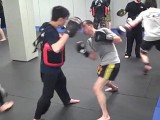The upper cut is a very powerful punch indeed. It is often used as a finisher move against opponents that have been worn down by fighting, and it is appropriately called a finisher because the fight usually ends by knock out if a successful uppercut is landed. It, along with the cross, is one of the main power punches performed by professional boxers and fighters, and in tournament settings, is counted for statistical tracking or points. In the real world, you hardly ever see uppercuts, because most people are facing untrained opponents. Those who get in fights without knowing how to fight often throw hooks or haymakers, which involve wide arcing movements that are easy to tell, easy to dodge, and easy to block. The uppercut however, has none of these traditional weaknesses. It easily gets by many opponents guards, and can be performed by either a lead weak hand as a opener or distraction, or by the strong hand as part of an ending combination. The only way to cleanly dodge an uppercut is to simply be out of range of the punch by moving backwards, but if you are in a limited space, like a ring or alleyway, that’s not always an option.

So, to perform the uppercut, we will of course start from our basic stance once more. After assuming the position, you’ll want to initiate this attack with the hand of your choice. By upper cutting with a lead hand, you lose some power, but gain speed and surprise, so let’s start there. You’ll want to make sure you are in close quarters with your opponent, as this technique is best done by slipping your lead hand between their guard during the movements. You’ll use mainly the trunk of your body for the power behind this punch. Start low, bringing the lead hand down a bit near their solar plexus, and exhaling as you propel the fist upwards. You’ll make a hook, like a pirate, while your fist connects with the bottom of their chin. You should be looking at the inside of your forearm as you complete the punch. Follow through until you reach their chin. Often times, their head will rock backwards, allowing you to propel the fist all the way up into the air before resuming the guard position.
Click Here To Learn More About Kickboxing Training in Portland!
For an uppercut with real power behind it, you’ll perform the same basic motions, but with your strong hand instead. The downside to this method of the uppercut is that while it is considerably more powerful, it’s harder to successfully connect. The reason behind the power is the same concepts as the power behind the cross. The hip rotation and full body involvement in the cross uppercut lends itself to greater momentum and force transference, but it is slower, easier to see it coming, and requires you to be even closer to your opponent. For these reasons, I would recommend that you only aim this uppercut at the solar plexus of an opponent, as the follow through on a missed uppercut to the chin leaves you open for attacks by the enemy.



